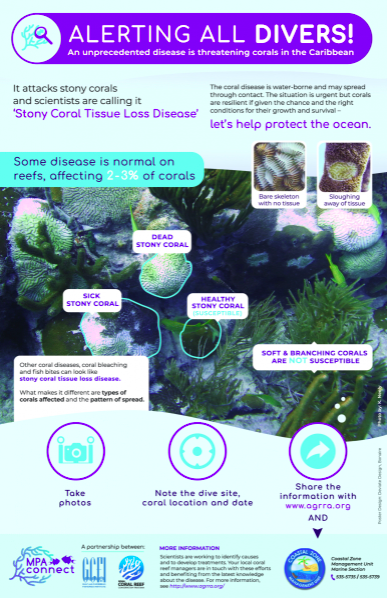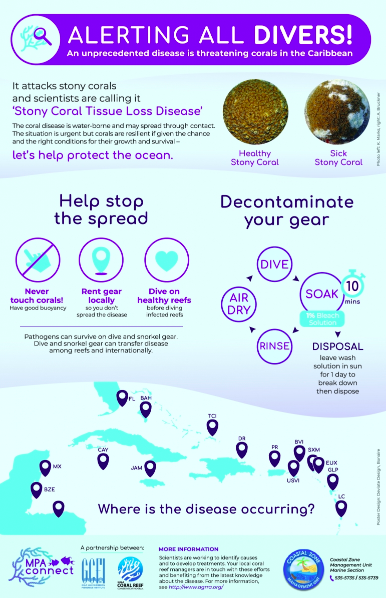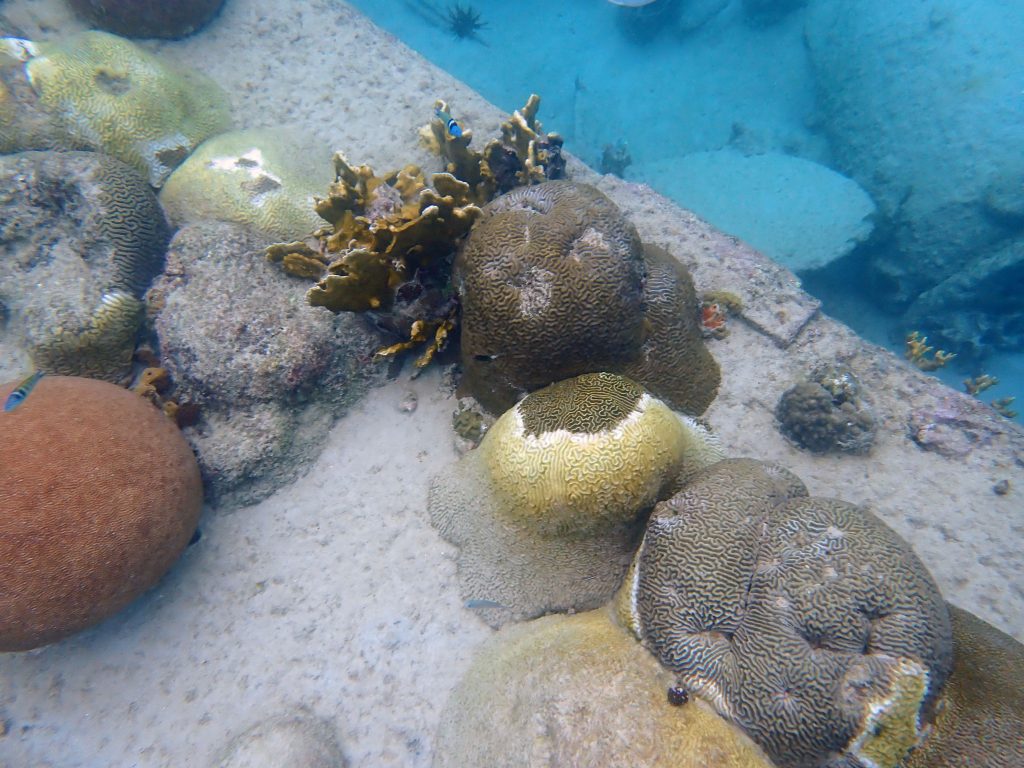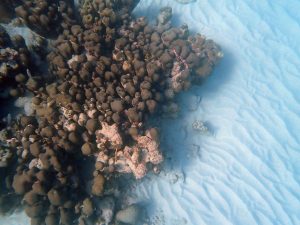Related pages:
– Lit & Links/Coral Diseases/SCTLD & WPD
– Notes & More Observations (sub-page of this page)
– Reports to AGRRA (sub-page of this page)
——-
UPDATE Apr 11, 2023: AGRRA confirms presence of Stony Coral Tissue Loss Disease in Barbados 10May2023
UPDATE 30 May, 2023: McGill students release their final report: Occurrence of Stony Coral Tissue Loss Disease on Vauxhall Reef and a Breakwater in the Folkstone Marine Protected Area of Barbados (28.7 MB)
UPDATE Feb 16, 2023 – SCTLD or White Plague Disease? – we don’t yet know: Based on a recent discussion with an authority on this disease, it’s not clear right now whether SCTLD is present in Barbados or whether what we are looking at is an outbreak of WPD (White Plague Disease), which has been reported to occur in Barbados in the past (see, e.g., Barbados Gov. 2012; Hoetles et al., 2002). One reservation about labelling the presumptive IDs as definitely SCTLD is the limited number of coral species so far recorded as possibly affected; notably missing amongst my “OICs” (Obviously Infected Corals), for example, are pillar corals which are known to be highly susceptible to SCTLD. (See my AGRRA Report #7 for examples of healthy pillar corals).
Because SCTLD and WPD are macroscopically similar and specific causative agents have not been identified for either disease, it is not a simple matter to confirm or not the presence of SCTLD in Barbados, at least not in early 2023. To distinguish between the two diseases we have to rely on information on patterns of spread of the diseases, and analyses of tissue samples combined with ongoing research on the nature of the associated microbial communities e.g., see
– Similarities and Differences Between Two Deadly Caribbean Coral Diseases: White Plague and Stony Coral Tissue Loss Disease, Aldo Cróquer et al. 2021 in Frontiers in Marine Science
– Experimental transmission of Stony Coral Tissue Loss Disease results in differential microbial responses within coral mucus and tissue, Naomi Huntley et al.m 2022 in Nature ISME
Reviewing the photos to date**with reference to descriptions of WPD and SCTLD in Cróquer et al., 2021, my interpretation would lean toward WPD rather than SCTLD. However, I must defer to experts for a definitive ID and as of yet, I am told, there is not enough info. to make one. (What we are seeing seems not to be highly typical of WPD disease either, e.g., O. annularis appears to be highly susceptible to WPD and as of yet, i haven’t seen much disease on this species.)
________
**See Photos under Notes & More Observations and Reports to AGRRA.
Both diseases are cause for concern – comment Croquer et al.,2021: “Our review shows that WPDs and SCTLD are the major causes of coral tissue loss in the Caribbean”.
Initially I labelled my observations of SCTLD “presumptive” because of my lack of experience identifying coral diseases; now it’s clear that was prudent regardless, although “possible” might be a better label than “presumptive”. The uncertainties underscore the need for more info. on the pattern and progress of whatever coral diseases we have in Barbados in early 2023.
It will be interesting to see how this story eventually unfolds, locally, regionally and in the scientific literature.
ORIGINAL PAGE/POST
Page and associated post created Jan 25, 2023; edits Feb 11, 2023; more updates at Notes & More Observations & Reports to AGRRA (sub-pages of this page).
SCTLD (Stony Coral Tissue Loss Disease) was first observed off the southeast coast of Florida in 2014 and appeared in the northern Caribbean by 2019. It kills the soft tissues of at least 22 species of corals and has been described as “deadliest coral disease ever recorded” (Wikipedia 25Jan2023).

Records of SCTLD in the Caribbean by year as reported on AGGRA 25Jan2023.
After reading about this disease in 2018 and the ominous forecasts of what it could do to Caribbean reefs, I kept an eye out for it in the Vauxhall Reef area during my visits in 2018, 2019 and 2020 but saw no sign of it. That was no surprise as it had not been reported anywhere close to Barbados over that interval. But by 2022 it had spread to the southern Caribbean, and there was a report of its occurrence on deeper reefs on the west coast of Barbados in early 2022, yet to be formally confirmed, on the AGGRA database (Locations: “Friars Craig”, 18 m, Dec 1, 2022, see e.g. this pic by S. Howell; and “near Allens”, 18 m, Nov 4, 2022, see e.g. this pic by R. Suckoo.)
Currently a page about this disease on the website of Coastal Zone Management Unit (Barbados), comments that “it has reached our neighbours in St. Lucia and the possibility of it making its way to Barbados is slowly increasing”. They ask for assistance in surveillance and reporting of any suspected cases of SCTLD.
UPDATE Feb 12, 2023: There is now a form for reporting observations of SCTLD in Barbados, see: STONY CORAL TISSUE LOSS DISEASE REPORT (Link updated May 8, 2023)
In early 2023 we returned to Barbados, Holetown area, after missing a couple of years due to Covid-related issues at home. On January 11, conditions were perfect for snorkelling at the Vauxhall Reef* and I looked out for SCTLD-infected corals on a route approx. perpendicular from shore that took me across the Reef Flat, Diploria-Palythoa, Reef Crest, Seaward Slope and Reef Front zones (Lewis 1960), to ‘The Wreck”. I saw only one obviously infected coral, that in the outer Reef Crest zone, until I reached The Wreck where there were many, and at least some of them appear to fit the description for Stony Coral Tissue Loss Disease. *My reference to “Vauxhall Reef” is to ‘Vauxhall Reef North’, which is Reef #34 in MacLean & Oxenford 2016; there is a second reef, #35 to the south of it, which they also call “Vauxhall Reef” ( ‘Vauxhall Reef South’ in my terminology).
Subsequently (Jan 12-21) I have criss crossed the Vauxhall Reef out to & including the Reef Front several times, and swum along the seaward edges of the next 2 fringing reefs to the north, finding about 30 “Obviously Infected Corals” in total but every time I look, I find more. (I do have precise records and photos and GPS positions, ‘still working through those). Currently, most of the infected corals (i.e., with symptoms characteristic of SCTLD) appear to be Pseudodiploria strigosa, Colpophyllia natans, Diploria labyrinthiniformis, Meandrites meandrina: possibly some Siderastrea siderea specimens are infected. All of these species are considered to be highly susceptible to SCTLD (see lists).
|
Meandrites meandrina with presumptive SCTLD Jan 13, 2023 in Folkestone MPA, north of Vauxhall Reefs; Reef Crest zone |
Diploria labyrinthiniformis, with presumptive SCTLD Jan 13, 2024 in Folkestone MPA north of Vauxhall Reefs, Reef Crest zone |
The particularly high concentration of diseased corals on The Wreck is curious. I wonder if it could be related to high nutrient levels associated with large schools of fish usually seen over the wreck, attracted in part by snorkelling operations feeding them; there is some evidence that coral diseases including SCTLD are stimulated by high nutrient levels. Alternatively, it might be related to the high intensity of pleasure boats, including some from other regions, visiting and mooring in the immediate area (re: ship borne spread of the disease) or to both factors (or neither).
I have not seen any signs of infection on Orbicella annularis, described as Highly Susceptible or Intermediately Susceptible to SCTLD. This coral was described by Lewis (1960) as the dominant species of shallow water Barbados reefs and it is still very prominent. Note added Feb 10, 2023: Nor have I seen it on pillar coral, which is fairly on these on these reefs and also described by AGRRA as a Highly Susceptible Species.
|
Healthy Orbicella annularis in the Reef Crest zone, Jan 25, 2023 |
Healthy Orbicella annularis on the bottom by The Wreck (Reef Front zone) Jan 21, 2023 |
So it seems SCTLD is in its early stages on Vauxhall Reef. Or is it?
I am not an expert of any sort on coral diseases (or even corals), so independent verification that what I have been seeing is indeed Stony Coral Tissue Loss Disease is still required. I have submitted a comment on my observations to the Barbados Coastal Zone Management group, and I submitted 4 records, each with 5 photos to AGRRA. A member of CORALL I met recently told me that some of their members have also recently seen what they suspect to be Stony Coral Tissue Loss Disease on shallow water reefs in Barbados.
While this is definitely bad news, there is a bit of good news. The Acroporoids, which have been making a comeback in Barbados (see MacLean & Oxenford, 2016), have so far shown no susceptibility to Stony Coral Tissue Loss Disease ( AGRRA). I observed all 3 Caribbean species on the Vauxhall Reef in 2015/6 and my observations to date in 2023 indicate that they continue to thrive. Also, there remain large numbers and diversity of fishes on this reef.
——
POSTERS BY BARBADOS COASTAL ZONE MANAGEMENT UNIT
“The posters outline decontamination procedures as well as the basic characteristics of the disease.” Note May 8, 2023. The website has been revised recently, and these posters do not seem to be available right now.
 |
 |
Forms to make reports:







